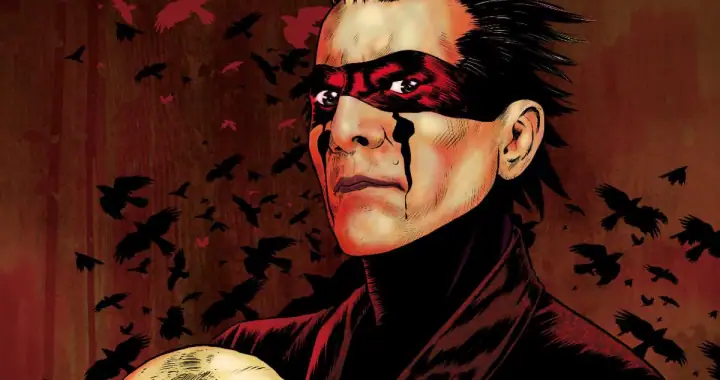Review: Pestilence Omnibus
 If you have read some of my reviews you will have probably noticed I’m not generally a fan of comic books or graphic novels that seek to fictionalize actual history or historical figures. It’s a personal failing but one I come by genuinely However, I am pleased to say that Pestilence, a book that presents a fictional account of the events surrounding the Black Plague in Europe, takes my usual cynicism toward this comic sub-genre and shatters it.
If you have read some of my reviews you will have probably noticed I’m not generally a fan of comic books or graphic novels that seek to fictionalize actual history or historical figures. It’s a personal failing but one I come by genuinely However, I am pleased to say that Pestilence, a book that presents a fictional account of the events surrounding the Black Plague in Europe, takes my usual cynicism toward this comic sub-genre and shatters it.
Off the top of my head, the only other members of the sub-genre that have grabbed and held my attention like this are “300” and “From Hell”, both excellent graphic novels. Pestilence stands right there with them, following the exploits of a group of soldiers in a fictional organization called “Fiat Lux” (Let there be light in Latin). Initially, we encounter this group hunting down and punishing ex-crusaders who are abusing their power and the general populace of The Holy Land. It is then they are tasked, by a zombie no less, to travel to Rome and consult with the Pope on a matter of utmost importance. These zombies, which the people in the story refer to as eaters, are a reasult of The Black Plague and feature in the aftermath of the plague as well. Fiat Lux then embark on an adventure that takes them to Rome, France and eventually England as they search for a way to overcome the various problems they encounter.  Political machinations within the church, roving bands of eaters and Satan himself all pop up at various times to challenge, attempt to eat and sometimes defeat Fiat Lux.
 What makes this book stand apart are the mature themes and unconventional plot choices that occur as the story progresses. The creative team pull no punches and actually kill off one of the main characters a few pages into the book. Death is common place in this tale and is sometimes depicted with a graphic casual indifference. Not to be outdone, the moral rot within Europe outside of and as a result of the plague, is also depicted in graphic detail. Full male and female nudity is displayed in scenes both sexual and non-sexual. Graphic acts of consensual and non-consensual activity are also drawn with an intensity that falls short of pornography or Hentai but leaves nothing to the imagination. Likewise, the language is sometimes salty and oftentimes shocking. Fair warning, this is not a book for the kiddies. However, all of these elements fit into the story being told and only rarely stray from out of the realm of necessary and into gratuitous. I will freely admit that it was a shocking read, but one that was effective in drawing me into the story while producing moments of revulsion and disgust. In truth, this book is as much a horror book as it is a work of historical fiction.
What makes this book stand apart are the mature themes and unconventional plot choices that occur as the story progresses. The creative team pull no punches and actually kill off one of the main characters a few pages into the book. Death is common place in this tale and is sometimes depicted with a graphic casual indifference. Not to be outdone, the moral rot within Europe outside of and as a result of the plague, is also depicted in graphic detail. Full male and female nudity is displayed in scenes both sexual and non-sexual. Graphic acts of consensual and non-consensual activity are also drawn with an intensity that falls short of pornography or Hentai but leaves nothing to the imagination. Likewise, the language is sometimes salty and oftentimes shocking. Fair warning, this is not a book for the kiddies. However, all of these elements fit into the story being told and only rarely stray from out of the realm of necessary and into gratuitous. I will freely admit that it was a shocking read, but one that was effective in drawing me into the story while producing moments of revulsion and disgust. In truth, this book is as much a horror book as it is a work of historical fiction.
The line work and inking Oleg Okuneve is impressive and treads a tricky line between being cartoonish and being overly realistic. Because of the graphic nature of many of the scenes, Okunev had a difficult task in presenting these actions while not going too far in one of those two directions. If Okunev had drifted into cartoon territory he would have diminished the impact and emotions these scenes were mean to illicit; too far into graphic realism and your book becomes a display of the obscene. The inking in this book is particularly strong and bold. Okunev’s strong inking gives his line work incredible depth and emphasizes small character points like scars or poses in order to reveal intricacies of the characters being drawn.  Similarly, the colorists make some interesting choices that put the focus directly on the various characters in the book. Much of the time, the colorists choose to minimally color the background elements of a panel and instead focus on the characters and the graphic aftermath of their actions. This choice is striking and manages to center the story where it belongs instead of the wider range of problems occurring across Europe as a whole. Finally, while I don’t often talk about book covers I felt that the covers by Tim Bradstreet were worth nothing and grading. Unlike the inner art, Bradstreet’s covers are drawn with incredible realism and convey a great depth of emotion and artistic skill.
Similarly, the colorists make some interesting choices that put the focus directly on the various characters in the book. Much of the time, the colorists choose to minimally color the background elements of a panel and instead focus on the characters and the graphic aftermath of their actions. This choice is striking and manages to center the story where it belongs instead of the wider range of problems occurring across Europe as a whole. Finally, while I don’t often talk about book covers I felt that the covers by Tim Bradstreet were worth nothing and grading. Unlike the inner art, Bradstreet’s covers are drawn with incredible realism and convey a great depth of emotion and artistic skill.
All in all this is an incredible work and one that, even though I enjoyed reading it, I will only read occasionally because of how graphic and shocking it could be. I was very pleased with the way the writers took this horrible moment in European history and managed to turn it into a horror story that seamlessly blended historical moments with moments of fantasy and true terror. Likewise, the artwork in this book faithfully partnered with the story. There are many books where either the words, story or artwork fail to stand up to the other elements in the book but this is not one of them. I highly recommend this book to anyone who is a fan of horror, medieval history, fantasy or the occult. However, I will repeat my warning that this is a book for adults and I feel that Aftershock would have been well served to put some sort of advisory to that affect on the cover.
Story – 5 of 5 Stars
Writing – 4 of 5 Stars
Art – 5 of 5 Stars
Covers – 5 of 5 Stars
Overall Score – 4.75 of 5 Stars
Writing – Frank Tieri
Story – Frank Tieri, Eric Bromberg, Brandon Auman
Art – Oleg Okunev
Color – Rob Schwager, Guy Major
Letters – Marshall Dillon
Covers – Tim Bradstreet
Publisher – Aftershock Comics
Author Profile
- Nemesis is a poet, writer and author of the upcoming novel The Long Game. He is a writer of science fiction and supernatural thrillers. Besides novels and short stories he writes for UK based ASAP Comics developing new stories for Level 8 and OPSEC. Nem is a graduate of the United States Military Academy at West Point and tries to bring those experiences into his writing.
He lives and works out of his home in Riverside, California with his wife and three children. When not writing he enjoys reviewing comic books and graphic novels for ComicCrusaders.com and living the Southern California life with his family.
Latest entries
 TV & MOVIESApril 30, 2024WonderCon 2024: Boy Kills World Interviews
TV & MOVIESApril 30, 2024WonderCon 2024: Boy Kills World Interviews Comic BooksNovember 8, 2023Review: Cyberpunk 2077 Library Edition Volume 1
Comic BooksNovember 8, 2023Review: Cyberpunk 2077 Library Edition Volume 1 GamingSeptember 21, 2023PC Game Review – Starfield
GamingSeptember 21, 2023PC Game Review – Starfield GamingSeptember 20, 2023TTRPG Review – Star Trek Captain’s Log
GamingSeptember 20, 2023TTRPG Review – Star Trek Captain’s Log






